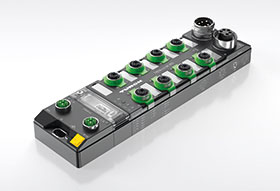

Data networks are frequently compared to road traffic. In this image, the cables are roads and motorways, and the switches represent crossings and motorway junctions. The task of the switch is to combine the data of many Ethernet stations on a main cable. The main cable can normally transport more data per second than the individual feeder lines.
Just like road traffic, data traffic is also constantly increasing. This development can be observed in office IT, in private households as well as in individual networks and operational technology (OT). The convergence of OT and IT is also boosting the increase of data streams. These must be ordered and distributed by switches. These consist of passive so-called ‘unmanaged’ switches or active ‘managed’ switches. While unmanaged switches basically only combine cables, managed switches actively control the data flow, prioritise it, assign IP addresses if necessary, establish redundant connections and secure the access to networks using firewalls.
Efficient wiring with IP67 switch
As an IP67 specialist, Turck has for some time been making possible out-of-the -cabinet decentralisation of automation technology. Besides the conventional I/O modules for connecting digital or analog signals or IO-Link devices to Ethernet networks, controllers and spanners for translating between Ethernet languages have also been set free from the control cabinet. The wiring and flexibility benefits arising from decentralised cabinet-free installation also apply to switches. Ethernet cables to the stations do not have to be routed individually from the control cabinet, but are only routed at the machine to the stations over the last metres. Depending on the system topology, the decentralised positioning of the switches saves considerable wiring effort.
Drag chains, redundancies, safety
Of course not every system requires a switch or several switches at the machine. Connecting stations with linear structures are certainly a major benefit of fieldbuses and Ethernet networks. In many cases, however, a star structure is required and so a switch is necessary: on drag chain applications, for example, it is highly impractical and laborious to route Ethernet cables at the end of the drag chain as a line. Several ports are likewise required when creating ring redundancies. The increased availability requirements placed on machines are another reason. Ring or star structures offer the highest level of reliability. With star structures, each station is connected to a separate port of the switch. Different line structures can be created via switches according to the particular machine architecture.
1 Gbps high-speed backbone and port-based IP address assignment
Turck’s new 10-port switch in the proven TBEN-L block module design offers 100 Mbps on eight ports and 1 Gbps on two high-speed backbone ports. The switch in the robust IP67 design is unique. It optimally meets the requirements of high-performance industrial applications in harsh environments. Users can assign the IP addresses to stations either by port or centrally via the web server of the switch. This saves the user having to make separate configurations for each individual station. For series machine builders and users integrating machines in higher-level networks, the switch with NAT routing offers higher-level systems the possibility to assign proxy IP addresses and thus prevent the doubling of IP addresses in networks. The embedded firewall ensures managed and, above all, secure data exchange for the integration.
High-speed tool changes with quick link-up times below 150 ms
The fast link-up time is a requirement which many industrial switches fail to provide. The ability to establish connections to stations in the shortest possible time is much more critical in industrial automation than in home or office IT scenarios. This must be carried out in fractions of a second, particularly with tool changes such as for car body manufacturing in the automobile industry. If there is a switch between the controller and station, the deployment of the tool not only depends on the startup time of the Ethernet station on the tool but also the link-up time of the switch. The quick link-up technology of the TBEN-L switch makes the tool changer operational in less than 150 milliseconds.
Wave breakers for broadcast and network load monitoring
Ethernet stations can send so-called broadcast requests which are directed to all stations of a network. These broadcast waves can put switches and other devices at the limits of their capabilities. The integrated broadcast storm protection reduces these kinds of network load spikes.
Virtual networks can also be set up for control via broadcast domains. These VLANs can then be used like individual networks and configured with VLAN-specific bandwidths. Broadcast requests are thus only functional in the virtual LAN. VLANs are also used to separate production and management data, which in turn effectively protects the availability and security of the production network. The network load monitoring of the switch helps on all ports to diagnose impending overloads early on and makes it possible to make predictive interventions.
Conclusion
A compact and powerful switch like the TBEN-LSE- M2 is new on the market. The combination of protection types up to IP69K and high-speed backbone with two Gbps ports is ideal for depicting the increasing networking of ever higher data rates in industrial networks. With fast link-up times below 150 milliseconds, the switch offers the highest cycle rates for tool changers in robot technology.
The user also benefits from the several functions for the safe and efficient organisation of industrial Ethernet networks. The integrated firewall therefore offers bidirectional protection from unauthorised access and thus reliably increases security in IIoT. This is in addition to the NAT routing capability or the possibility to set up virtual LANs.
| Tel: | +27 11 453 2468 |
| Email: | [email protected] |
| www: | www.turckbanner.co.za |
| Articles: | More information and articles about Turck Banner Southern Africa |

© Technews Publishing (Pty) Ltd | All Rights Reserved